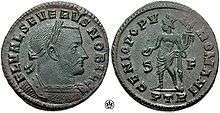Valerius Severus
| Valerius Severus | |||||||||
|---|---|---|---|---|---|---|---|---|---|
| Augustus of the Western Roman Empire | |||||||||
 Flavius Valerius Severus as Caesar (305–306) | |||||||||
| Emperor of the Roman Empire | |||||||||
| Reign |
1 May 305 – summer 306 (as Caesar in the west under Constantius Chlorus); summer 306 – March or April 307 (as Augustus in the west, in competition with Constantine, Maxentius, and Maximian) | ||||||||
| Predecessor | Constantius I | ||||||||
| Successor | Maxentius, Licinius | ||||||||
| Co-emperor | Galerius (Eastern Emperor) | ||||||||
| Born | Illyria | ||||||||
| Died |
September 307 Tres Tabernae | ||||||||
| Issue | Flavius Severianus | ||||||||
| |||||||||
Valerius Severus (Latin: Flavius Valerius Severus Augustus;[1] died September 307), also Severus II,[2] was a Western Roman Emperor from 306 to 307. After failing to besiege Rome, he fled to Ravenna. It is thought that he was killed there or executed near Rome.
Officer in the Roman army
Severus was of humble birth, born in Northern Illyria (now Serbia) around the middle of the third century AD.[3][4] He rose to become a senior officer in the Roman army,[3] and as an old friend of Galerius, that emperor ordered that Severus be appointed Caesar of the Western Roman Empire, a post that he succeeded to on 1 May 305.[5] He thus served as deputy-emperor to Constantius I (Constantius Chlorus), Augustus of the western half of empire.[3]
Augustus, 306–307
On the death of Constantius I in Britain in the summer of 306, Severus was promoted to Augustus by Galerius, in opposition to the acclamation of Constantine I (Constantius' son) by his own soldiers.[6][7] When Maxentius, the son of the retired emperor Maximian, revolted at Rome, Galerius sent Severus to suppress the rebellion. Severus moved towards Rome from his capital, Mediolanum, at the head of an army previously commanded by Maximian.[3] Fearing the arrival of Severus, Maxentius offered Maximian the co-rule of the empire. Maximian accepted, and when Severus arrived under the walls of Rome and besieged it, his men deserted to Maximian, their old commander. Severus fled to Ravenna, an impregnable position.[3] Maximian offered to spare his life and treat him humanely if he surrendered peaceably, which he did in March or April 307. Despite Maximian's assurance, Severus was nonetheless displayed as a captive and later imprisoned at Tres Tabernae.[3] One belief is that when Galerius himself invaded Italy to suppress Maxentius and Maximian, the former ordered Severus's death, and that he was executed (or forced to commit suicide) on September 307 at Tres Tabernae, near the current Cisterna di Latina.[4] Another belief is that Severus II was killed in Ravenna.[5][8]
Severus was survived by his son Flavius Severianus.
References
- ↑ In Classical Latin, Severus' name would be inscribed as FLAVIVS VALERIVS SEVERVS AVGVSTVS.
- ↑ Enumerated after Septimius Severus (skipping Severus Alexander).
- 1 2 3 4 5 6 Michael DiMalo (1998). "Severus II". An Online Encyclopedia of Roman Emperors. Retrieved 1 August 2015.
- 1 2 "Aurelius Victor, About Caesar" (in Russian). Ancient Rome. Retrieved 1 August 2015.
- 1 2 "Biography of Emperor Constantine" (in Russian). Ancient Rome. Retrieved 1 August 2015.
- ↑ Barnes, Timothy David (1982). The New Empire of Diocletian and Constantine. Harvard University Press. pp. 26–27. ISBN 0-7837-2221-4.
- ↑ Lactantius. "On the death of the persecutors". p. 5. Retrieved 1 August 2015.
- ↑ Baronio, Annales Ecclesiastici, vol. 1, pp. 769-770
External links


Valerius Severus Born: Unknown Died: September 307 | ||
| Regnal titles | ||
|---|---|---|
| Preceded by Constantius Chlorus |
Roman Emperor 306–307 Served alongside: Galerius |
Succeeded by Licinius |
| Political offices | ||
| Preceded by Constantius Chlorus , Galerius |
Consul of the Roman Empire 307 with Maximinus Daia , Galerius, Maximian, Constantine I |
Succeeded by Diocletian , Galerius, Maxentius, Valerius Romulus |